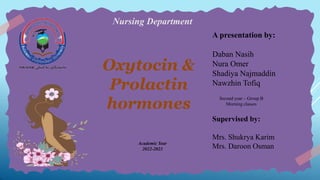
Prolactin & Oxytocin.pptx
- 1. Second year – Group B Morning classes A presentation by: Daban Nasih Nura Omer Shadiya Najmaddin Nawzhin Tofiq Supervised by: Mrs. Shukrya Karim Mrs. Daroon Osman Nursing Department Academic Year 2022-2023 Oxytocin & Prolactin hormones
- 2. Oxytocin ▶ Source of Secretion: ▶ Secreted mainly by paraventricular nucleus and partly supraoptic nuclei. ▶ T ransported from hypothalamusto posterior pituitary through the nerve fibers of hypothalamo-hypophyseal tract. ▶ In the posterior pituitary, the oxytocin is stored in the nerve endings of hypothalamo-hypophyseal tract. ▶ When suitable stimuli reach the posterior pituitary from hypothalamus, oxytocin is released into the blood. ▶ Oxytocin is secreted in both males and females.
- 3. ▶ Actiononmammaryglands ▶ Causes ejection of milk from the mammary glands. ▶ Oxytocin causes contraction of the myoepithelial cellsand flow of milk from alveoli of mammary glands to the exterior through duct system and nipple. ▶ The process by which the milk is ejected from alveoli of mammary glands iscalled milk ejection reflex or milk letdownreflex. ▶ It isone of the neuro-endocrine reflexes.
- 4. ▶ ActiononUterus: ▶ Oxytocin actson: 1 . Pregnant uterus 2. Non-pregnant uterus.
- 5. ⦁ On pregnant uterus: ▶ Throughout the period of pregnancy, oxytocin secretion isinhibited by estrogen and progesterone. ▶ At the end of pregnancy, the secretion of these two hormones decreases suddenly and the secretion of oxytocin increases. ▶ Oxytocin causes contraction of uterus and helps in the expulsion of fetus. ▶ Itis also an example of neuro-endocrine reflex and positive feedback mechanism
- 6. ▶ Onnon-pregnantutreus: ▶Action of oxytocin on non-pregnant uterus is to facilitate the transport of sperms through female genital tract up to the fallopian tube, by producing the uterine contraction during sexual intercourse.
- 7. Prolactin ⯈Human prolactin is a single- chain polypeptide of 199 amino acids. It has a molecular weight of 23 kDa. ⯈ Prolactinis synthetizedin and secretedfrom specializedcellsof the anterior pituitary gland, the lactotrophcells. ⯈ Thepituitary gland(also calledasthe master gland)is an endocrinegland about the size of apea (weighing0.5 g)and locatedat the baseof the brain(just belowthe hypothalamus).
- 8. FUNCTION ⯈Prolactinis responsibleof: Primarily, initiating and sustaininglactation and Stimulation of breastdevelopment alongwith Estrogen during pregnancy.
- 9. Prolactinsecretioniscausedby; • Prolactin releasinghormone (PRH) • Estrogen (during stimulates lactotropes to secrete prolactin) • Oxytocin (causes muscle contractions to expel milk) • Vasoactiveintestinal peptide(VIP) • Thyrotropin releasinghormone (TRH) • Breast feeding • Stress • Sleep • Dopamine antagonists (eg., antipsychotic drugs) • Chest wall trauma
- 10. Hypoprolactinemia ⯈ Hypoprolactinemia - decreased prolactin hormone secretion by the anterior pituitary gland. ⯈ Commoncausesof Hypoprolactinemia: Sheehan’ssyndrome Hypopituitarism Excessdopamine Autoimmunedisease Growth hormonedeficiency Head injury Infection ⯈ Symptoms: Ovarian diseases,delayedpuberty and infertility. Impotenceand abnormal spermatogenesis.
- 11. Hyperprolactinemia ⯈Hyperprolactinemia– increasedprolactin hormonesecretionbythe anterior pituitary gland. ⯈ Commoncausesof Hyperprolactinemia: Stress Medications (e.g,Antipsychoticdrugs) Primaryhypothyroidism Pituitary glandtumour Prolactinoma ⯈ Symptoms: • Oligomenorrhoea • Amenorrhoea • Galactorrhoea • Infertility • Hirsutism • Osteoporosis
- 12. DIAGNOSIS ⯈Diagnosis: • History(medication,oligomenorrhoea,hirsutism) • Physical examination(Galactorrhoea) • Laboratory Pregnancytest Prolactin Macroprolactin TSH, FreeT4 U& Es Tes, LH andFSH • MRI scan(Prolactinaemia) • Visualfieldtests (optic nerve)
- 13. • HyperProlactinaemia:dopamineagonists (e.g., Bromocryptine orCabergoline) • Surgeryremovaland/or radiationtherapy (largepituitary tumours) • Thyroidabnormalities:thyroid hormone replacement (e.g., levothyroxine) • Ovarianinsufficiency:hormonaltherapy (e.g., Estrogen andprogestins) TREATMENT